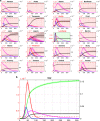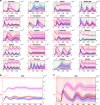A network model of Italy shows that intermittent regional strategies can alleviate the COVID-19 epidemic
- PMID: 33037190
- PMCID: PMC7547104
- DOI: 10.1038/s41467-020-18827-5
A network model of Italy shows that intermittent regional strategies can alleviate the COVID-19 epidemic
Abstract
The COVID-19 epidemic hit Italy particularly hard, yielding the implementation of strict national lockdown rules. Previous modelling studies at the national level overlooked the fact that Italy is divided into administrative regions which can independently oversee their own share of the Italian National Health Service. Here, we show that heterogeneity between regions is essential to understand the spread of the epidemic and to design effective strategies to control the disease. We model Italy as a network of regions and parameterize the model of each region on real data spanning over two months from the initial outbreak. We confirm the effectiveness at the regional level of the national lockdown strategy and propose coordinated regional interventions to prevent future national lockdowns, while avoiding saturation of the regional health systems and mitigating impact on costs. Our study and methodology can be easily extended to other levels of granularity to support policy- and decision-makers.
Conflict of interest statement
The authors declare no competing interests.
Figures





References
-
- Calafiore, G. C., Novara, C. & Possieri, C. A modified SIR model for the COVID-19 contagion in Italy. Preprint at https://arxiv.org/abs/2003.14391 (2020). - PMC - PubMed
-
- Hethcote HW. The mathematics of infectious diseases. SIAM Rev. 2000;42:599–653. doi: 10.1137/S0036144500371907. - DOI
-
- Peng, L., Yang, W., Zhang, D., Zhuge, C. & Hong, L. Epidemic analysis of COVID-19 in China by dynamical modeling. Preprint at https://arxiv.org/abs/2002.06563 (2020).
Publication types
MeSH terms
LinkOut - more resources
Full Text Sources

